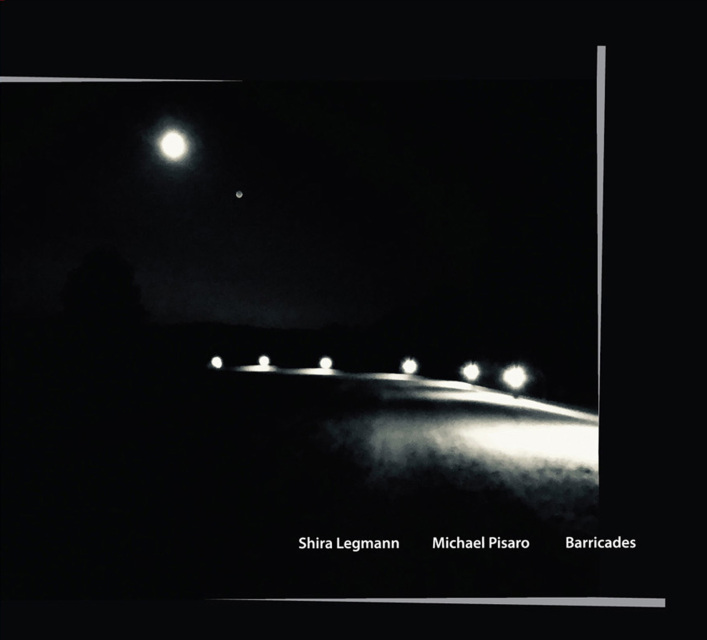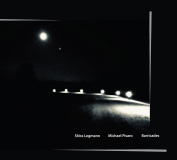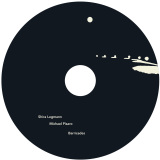- Shira Legmann
- >
- Shira Legmann / Michael Pisaro - Barricades (Lossless)
Shira Legmann / Michael Pisaro - Barricades (Lossless)
SKU:
$10.00
$10.00
Unavailable
per item
Lossless Digital AIFF (16bit/44k)
elsewhere 009
This album contains LA-based composer Michael Pisaro's recent composition 'Barricades,' a 63-minute piece for piano and electronics. Consisting of thirteen studies (piano pieces, some with electronics) and two electronic interludes, the piece is performed by Israel-based pianist Shira Legmann, with Pisaro on electronics. Cover photo by Michael Pisaro, design by Yuko Zama.
For CD format, go to this page.
For digital HD FLAC (24/96), go to this page.
|
TRACK LIST
1. Study No. 1 5:38 2. Study No. 2 3:20 3. Study No. 3 1:53 4. Study No. 4 2:01 5. Study No. 5 2:15 6. Study No. 6 2:04 7. Interlude No. 1 2:03 8. Study No. 7 4:47 9. Study No. 8 6:41 10. Study No. 9 3:42 11. Study No. 10 10:30 12. Study No. 11 1:42 13. Study No. 12 3:37 14. Interlude No. 2 4:45 15. Study No. 13 8:29 (released June 22, 2019) CREDITS
Shira Legmann - piano Michael Pisaro - electronics composed by Michael Pisaro recorded by Michael Pisaro at The Wild Beast (CalArts, Valencia, California) in March-April, 2019 piano: Yamaha CF III S, Serial No. 5543100 mixed and mastered by Michael Pisaro photography by Michael Pisaro design by Yuko Zama produced by Yuko Zama with special thanks to Fred Tauber & the Avaloch Farm Music Institute p+c 2019 elsewhere music |
"Barricades has a distant but decisive relationship to the keyboard music of Louis and François Couperin. The title refers to 'Les Barricades Mystérieuses' by François Couperin – and to the technique of overlapping, interlocking voices, creating a thicket or web-like texture. I have loved the music of the Couperins since college, but it was when Shira sent me some of her favorite music to play, and 'Les Barricades Mystérieuses' was among the scores, that the idea for this piece began to crystallize. The process of writing and working on the piece with Shira was one of watching the barricades, which I pictured as a network of twisted vines, unravel." (Michael Pisaro)
Shira Legmann's clean, supple yet solid piano sounds, employing a wide dynamic range, add a sense of organic life to the composition. Her whispery nuances and mysterious atmosphere, intertwining with Pisaro's underlying sine tones, create a compelling balance between coolness and emotion, distance and closeness, and result in a tranquil yet captivating contemporary work with an echo of the French Baroque. REVIEWS
Bill Meyer, Dusted Magazine Barricades takes its name from “Les Barricades Mystérieuses,” a composition by the Baroque composer and keyboardist, François Couperin. The work of Couperin and his family, whose members played the organ at the church of Saint Gervais in Paris for several generations, is a long-time favorite of Pisaro’s. But the instigation for writing music inspired by Couperin came when Pisaro found out that he shared this affinity with Shira Legmann, an Israeli pianist whose repertoire encompasses music of the Baroque era and the late 20th century. He wrote the fifteen piano studies that make up Barricades, and played the electronics that appear on certain of the studies and two purely electronic interludes. And he recorded it himself at The Wild Beast, a concert hall located on the CalArts campus where Pisaro teaches. While Pisaro wrote the piece, he did so in consultation with Legmann, and he’s written of the experience as being “one of watching the barricades, which I pictured as a network of twisted vines, unravel.” While the music is made up of ornaments and interlocking patterns, both of which are defining devices of the Baroque era, they have been abstracted. Instead of adding elaborate figures, he adorns the piano with decaying swells and sine tones. And instead of fitting parts so closely that they lock together, Legmann’s cleanly articulated lines span empty spaces like power lines. The pattern is a spacious web, bounded but barely solid. This redirects the listener’s attention from the watch-like action of your average Baroque to the individual turns of the gear; put another way, the focus is on the manipulation and decay of each note rather than the precise action of a machine made of notes. While this discussion has focused on process, it’s quite possible to appreciate this music without doing so. Instead one can appreciate the elegance of Legmann’s clean arcs, as well as the quietly strategic way that Pisaro shades and smudges them. Michele Palozzo, esoteros The past as an archive and treasure chest of infinite discoveries, a retroactive immensity within which one can relive and reimagine the insights of superfine minds that succeeded each other over time. The course of the centuries has perpetuated the most brilliant inventions as, in some cases, the enigmas that the figure of the artist has always enjoyed in ordering at the expense of his audience. Such is the case of a rondeau contained in the 6th Order of the harpsichord pieces by François Couperin (1668-1733): "Les Barricades Mystérieuses" is a polyphonic interweaving of melodies that captivate each other with studied delays, in a whirling carousel of rhythms and harmonies in perfect balance, within which, however, spontaneous and fleeting dissonances also arise. It would be difficult to imagine a link between the opulent ornamentation of the Baroque style and the reductionist aesthetics of Michael Pisaro, one of the true masters of the radical avant-garde collective Wandelweiser . Yet the fascination for such an eccentric musical charade has filled the historical distance between the two composers, finding in the cycle of piano studies "Barricades" (2018-2019) a fascinating contemporary parallel. After the symbiotic bond established with the talented Reinier van Houdt - interpreter of the integral " The Earth And The Sky " (Erstwhile, 2016) and of the sound poem " Shades Of Eternal Night " (Gravity Wave, 2018) - Pisaro finds a new ally in the German pianist Shira Legmann, not by chance fluent either in the period repertoire Bachian than in the complexity of the modern languages of Messiaen, Ligeti, Scelsi and Feldman: in retrospect, a crucial condition sine qua non for the deep understanding of the concept and spirit of "Barricades". 'The piano and its double', one might think in hearing, from the first minutes, the extensions and artificial inversions operated by Pisaro on the resonant strings. As in his time Luigi Nono put in dialogue the live performance and the reworked tape recording of the same Maurizio Pollini ("... suffered serene waves ..."), so the American master brings out the purity of the acoustic sound of Legmann amplifying it through a parallel simulacrum, a discreet shadow that nevertheless ends up taking on the role of a secondary character in the delineation of a "foreign" and timeless musical dimension, not easily divisible into minimal stylistic terms. In fact, although predominantly clear and caressing, the melodies on the pentagram are also in a certain way “dry”, unfolded in an atmosphere of voluntary solitude that make their coordinates uncertain: it often becomes almost impossible to discern the measured baroque instruments from the sequences in a questioning tone of Feldman (No. 7, 9, 12) or by the peaceful grace of Satie and Sakamoto . To the direct interventions on the Legmann audio source is added in several cases one of the distinctive figures of Pisaro, namely the short waves: these soft and perfectly linear shades are to all effects the "counter-melody" of the melody, a continuous bass that balances the elegant piano volutes with a stable height complementary to them (No. 4, 10, 13). The two interlude to the étudesinstead, they are pure environmental abstractions that seem to cover the piano with a thick blanket of fog - short dreamlike glances beyond the threshold of a distorting mirror. These, in essence, the "enigmas" by which Pisaro embroiders the role of postmodern Couperin, also here in the full (and apparently casual) capacity to make their own historicized influences and suggestions and channel them into an exclusively personal vision. After " Cheminant " and " Lettres et Replis”, With“ Barricades ”ideally closes a laudable triplet of piano-themed publications published by Elsewhere by Yuko Zama, which just a year after the foundation already boasts a catalog of classical-contemporary alterities with a clear and coherent curatorial imprint. It will take some time before the "high" culture recognizes in these vast post- cagean drifts the newest and most authentic frontier of today's composition. (1/2/2020) John Eyles, All About Jazz "Instead of confining a listener within a small individual universe of the composer or the performer, Pisaro's piano pieces seem to take the listener to another dimension or another space -with some mystic power of induction, beyond the limited space that the solid, vertical texture of the piano sounds generally tend to create." There was a certain inevitability about Elsewhere releasing a Michael Pisaro recording. Not only has Yuko Zama been involved with Erstwhile during the years when Pisaro had a steady stream of albums released by the label, she has also been the designer on many of Pisaro's releases on his Gravity Wave label. In addition, Zama has sung Pisaro's praises in her reviews; the quote above coming from her review of Fields Have Ears (Another Timbre, 2010) for her blog View from Elsewhere. (Incidentally, each of the nine Elsewhere releases so far has included at least one musician who has featured on Another Timbre.) Barricades consists entirely of the sixty-three-minute title composition, written by Pisaro in 2018-19 for the Israel-based pianist Shira Legmann after he discovered that one of her favourite pieces of music was the 1717 harpsichord piece 'Les Barricades Mystérieuses' by the French Baroque composer François Couperin. Listening to Pisaro's fifteen-part composition, the most immediately obvious connection to Couperin's piece is its arpeggiated style, and its title "Barricades," maybe intended as a clue. It features Legmann's piano with Pisaro himself playing background sine tones, with those tones being the only sounds heard on the composition's two interludes, creating a dramatic atmosphere. On the thirteen studies that form the main body of the composition, piano and tones combine together effectively, creating music that encompasses a range of moods and emotions, and will be well received by established Pisaro aficionados and newcomers alike. This Piano Series consists of three distinctively different recordings, any one of which would have attracted attention and plaudits in its own right. It is a measure of the quality of the series that it is impossible to single out one of the three as being the best of the bunch; they are different but equal. Roll on Series No. 2... (7/28/2019) Eyal Hareuveni, The Free Jazz Collective The concept of Barricades began to crystallize when Israeli pianist Shira Legmann sent American experimental composer Michael Pisaro a list of her favorite music and included Les Barricades Mystérieuses by French Baroque composer François Couperin (1668-1733). Legmann’s wide repertoire encompases not only compositions from the Baroque but also Olivier Messiaen's Vingt Regards sur l'enfant-Jésus, György Ligeti's keyboard music, Morton Feldman’s late repertoire and Giacinto Scelsi's piano music. Pisaro himself loved the idea of composing a web-like texture that refers to Couperuin’s polyphonic technique of overlapping and interlocking voices. Pisaro compared the process of composing and working with Legmann on Barricades to “watching the barricades, which I pictured as a network of twisted vines, unravel.” Barricades consists of thirteen “studies” for Legmann’s piano with some sine waves played by Pisaro himself, who adds two interludes where he plays the sine waves. The album was recorded by Pisaro at CalArts, California on March and April 2019, later mixed and mastered by Pisaro. Pisaro’s subtle, ethereal sine waves sound as organic extension of Legmann’s clean and supple piano presence. Legmann navigates wisely the enigmatic atmosphere of Barricades as if she is determined to blur the transparent sonic barricades between the dramatic and the cool and restrained, between the emotional and the cerebral or between the distant and what may be considered close. Her “studies” with Pisaro’s eerie “interludes” suggest a fragile balance between these somehow abstract concepts. Together, these pieces reflect the very nature of Barricades, a poetic attempt to create a captivating network of sonic vines that grow in their own accord and intensify by their inner logic; a network of pieces that not only echoes the French Baroque but also flows in a unique, fragile equilibrium. A dreamy and hypnotic, Feldman-esque equilibrium between the concrete and the imagined, the acoustic and its electronic extension, the earthly and the celestial. (9/14/19) |




